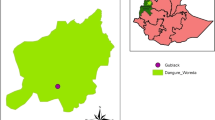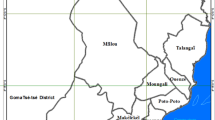Abstract
The severe malaria (SM) and uncomplicated malaria (UM) infections are expected to have different genetic makeup. In this study, blood samples were obtained from 325 donors with SM and UM and malaria-free donors (including asymptomatic submicroscopic malaria—ASUM), from Eastern Sudan. The SM group included patients with cerebral malaria (CM), severe malarial anemia (SMA), and other complications. The MSP2 locus was exploited for parasite genotyping. We found that the genetic diversity of the parasite population was marked (51 genotypes). The overall multiplicity of infection (MOI) was 1.5, and it was comparable between SM and UM. However, the MOI in ASUM (1.0) and fatal CM (1.14) was comparable and significantly lower than in UM (1.53), SMA (1.52), and nonfatal CM (1.7). The ratio of the IC1 to FC27 allele families was comparable between SM and UM, and the distribution of the allele sizes was correlated (correlation coefficient = 0.59 and 0.718; P < 0.001). It is interesting to note that the FC27 genotype was overrepresented in ASUM (68.2%) and was not recognized in fatal CM, while in mixed-clone infections, the clearance of IC1 after quinine treatment was faster than FC27 clearance. Finally, the composition of the multiclone infections (IC1 and FC27) was suggesting a stronger cross-immunity within rather than between MSP2 gene families.


Similar content being viewed by others
Reference
al-Yaman F, Genton B, Reeder JC, Anders RF, Smith T, Alpers MP (1997) Reduced risk of clinical malaria in children infected with multiple clones of Plasmodium falciparum in a highly endemic area: a prospective community study. Trans R Soc Trop Med Hyg 91:602–605
Ariey F, Hommel D, Le Scanf C, Duchemin JB, Peneau C, Hulin A, Sarthou JL, Reynes JM, Fandeur T, Mercereau-Puijalon O (2001) Association of severe malaria with a specific Plasmodium falciparum genotype in French Guiana. J Infect Dis 15:237–241
Arnot D (1998) Unstable malaria in Sudan: the influence of the dry season. Clone multiplicity of Plasmodium falciparum infections in individuals exposed to variable levels of disease transmission. Trans R Soc Trop Med Hyg 92:580–585
Babiker HA, Lines J, Hill WG, Walliker D (1997) Population structure of P. falciparum in villages with different malaria endemicity in east Africa. Am J Trop Med Hyg 56:141–147
Branch OH, Takala S, Kariuki S, Nahlen BL, Kolczak M, Hawley W, Lal AA (2001) P. falciparum genotypes, low complexity of infection, and resistance to subsequent malaria in participants in the Asembo Bay Cohort Project. Infec Immun 69:7783–7792
Brown GV, Beck HP, Molyneux M, Marsh K (2000) Molecular approaches to epidemiology and clinical aspects of malaria. Parasitol Today 16:448–451
Conway DJ, McBride JS (1991) Genetic evidence for the importance of interrupted feeding by mosquitoes in the transmission season. Trans R Soc Trop Med Hyg 85:454–456
Engelbrecht F, Felger I, Genton B, Alpers M, Beck HP (1995) Plasmodium falciparum: malaria morbidity is associated with specific merozoite surface antigen 2 genotypes. Exp Parasitol 81:90–96
Farnert A, Rooth I, Svensson A, Snounou G, Bjorkman A (1999) Complexity of Plasmodium falciparum infections is consistent over time and protects against clinical disease in Tanzanian children. J Infect Dis 179:989–995
Felger I, Tavul L, Kabintik S, Marshall V, Genton B, Alpers M, Beck HP (1994) Plasmodium falciparum: extensive polymorphism in merozoite surface antigen 2 alleles in an area with endemic malaria in Papua New Guinea. Exp Parasitol 79:106–116
Giha HA, Elghazali G, A-Elgadir TME, A-Elbasit IE, Eltahir EM, Baraka OZ, Khier MM, Adam I, Troye-Blomberg M, Theander TG, Elbashir MI (2005) Clinical pattern of severe Plasmodium falciparum malaria in Sudan in an area characterized by seasonal and unstable malaria transmission. Trans R Soc Trop Med Hyg 99:243–251
Giha HA, Elbashir MI, A-Elbasit IE, A-Elgadir TME, Elghazali GE, Mackinnon MJ, Babiker HA (2006) Drug resistance–virulence relationship in Plasmodium falciparum causing severe malaria in an area of seasonal and unstable transmission. Acta Trop 97:181–187
Greenwood B, Marsh K, Snow R (1991) Why do some African children develop severe malaria? Parasitol Today 7:277–281
Henning L, Schellenberg D, Smith T, Henning D, Alonso P, Tanner M, Mshinda H, Beck HP, Felger I (2004) A prospective study of Plasmodium falciparum multiplicity of infection and morbidity in Tanzanian children. Trans R Soc Trop Med Hyg 98:687–694
Konate L, Zwetyenga J, Rogier C, Bischoff E, Fontenille D, Tall A, Spiegel A, Trape JF, Mercereau-Puijalon O (1999) Variation of Plasmodium falciparum msp1 block 2 and msp2 allele prevalence and of infection complexity in two neighbouring Senegalese villages with different transmission conditions. Trans R Soc Trop Med Hyg 93:21–28
Mayor A, Saute F, Aponte JJ, Almeda J, Gomez-Olive FX, Dgedge M, Alonso PL (2003) Plasmodium falciparum multiple infections in Mozampique, its relation to other malariological indices and to prospective risk of malaria morbidity. Trop Med Int Health 8:3–11
Molineaux L (1996) Plasmodium falciparum malaria: some epidemiological implications of parasite and host diversity. Ann Trop Med Parasitol 90:379–393
Ntoumi F, Contamin H, Rogier C, Bonnefoy S, Trape JF, Mercereau-Puijalon O (1995) Age-dependent carriage of multiple P. falciparum merozoite surface antigen-2 alleles in asymptomatic malaria infections. Am J Trop Med Hyg 52:81–88
Ofosu-Okyere A, Mackinnon MJ, Sowa MP, Koram KA, Nkrumah F, Osei YD, Hill WG, Wilson MD, Arnot DE (2001) Novel Plasmodium falciparum clones and rising clone multiplicities are associated with the increase in malaria morbidity in Ghanian during the transition into the high transmission season. Parasitology 123:113–123
Plowe CV, Djimde A, Bouare M, Doumbo O, Wellems TE (1995) Pyrimethamine and proguanil resistance-conferring mutations in Plasmodium falciparum dihydrofolate reductase: polymerase chain reaction method for surveillance in Africa. Am J Trop Med Hyg 52:565–568
Ranford-Cartwright LC, Balfe P, Carter R, Walliker D (1993) Frequency of cross-fertilization in the human malaria parasite Plasmodium falciparum. Parasitology 107:11–18
Roper C, Richardson W, Elhassan IM, Giha H, Hviid L, Satti GM, Theander TG, Arnot DE (1998) Seasonal changes in the Plasmodium falciparum population in individuals and their relationship to clinical malaria: a longitudinal study in a Sudanese village. Parasitology 116:501–510
Smith T, Beck HP, Kitua A, Mwankusye S, Felger I, Fraser-Hurt N, Irion A, Alonso P, Teuscher T, Tanner M (1999) Age dependence of the multiplicity of Plasmodium falciparum infections and of other malariological indices in an area of high endemicity. Trans R Soc Trop Med Hyg 93:15–20
Snow RW, Omumbo JA, Lowe B, Molyneux CS, Obiero JO, Palmer A, Weber MW, Pinder M, Nahlen B, Obonyo C, Newbold C, Gupta S, Marsh K (1997) Relation between severe malaria morbidity in children and level of Plasmodium falciparum transmission in Africa. Lancet 349:1650–1654
WHO (2000) Severe falciparum malaria. World Health Organization, communicable diseases cluster. Trans R Soc Trop Med Hyg 94(1):S1–S90
WHO (2003) The global malaria situation: current tools for prevention and control. 55th World Health Assembly. Global Fund to Fight AIDS, Tuberculosis and malaria. WHO document no. A55/INF.DOC./6.Available at: http://www.who.int/gb/EB_WHA/PDF/WHA55/ea55id6.pdf. Accessed 7 July 2003
Acknowledgment
The patients and the healthy volunteers, the Gedarif Teaching Hospital staff, and our field team: Adil Ameen, Faiz Omer, and Mustafa Hamid, are all acknowledged for the unlimited cooperation. This study received financial support from the UNDP/World Bank/WHO Special Programme for Research and Training in Tropical Diseases (TDR) and the Multilateral Initiative on malaria in Africa (MIM), project ID A00003. We declare that the experiments done in this study were complying with the current laws of the Sudan.
Author information
Authors and Affiliations
Corresponding author
Rights and permissions
About this article
Cite this article
A-Elbasit, I.E., ElGhazali, G., A-Elgadir, T.M.E. et al. Allelic polymorphism of MSP2 gene in severe P. falciparum malaria in an area of low and seasonal transmission. Parasitol Res 102, 29–34 (2007). https://doi.org/10.1007/s00436-007-0716-3
Received:
Accepted:
Published:
Issue Date:
DOI: https://doi.org/10.1007/s00436-007-0716-3




